There’s no doubting that cycling is greener than most transport methods, but is the way your bike gets manufactured eco-friendly? Find out what Trek, Specialized and others are doing to improve their eco credentials
As the world becomes more environmentally conscious, it’s clear that bikes can play a large part in reducing our emissions; but just because they’re part of the solution, it doesn’t mean they don’t have any carbon footprint at all. We talked to some industry experts in an attempt to find out how just large that footprint is, and whether the bike industry may be getting something of an environmental pass.
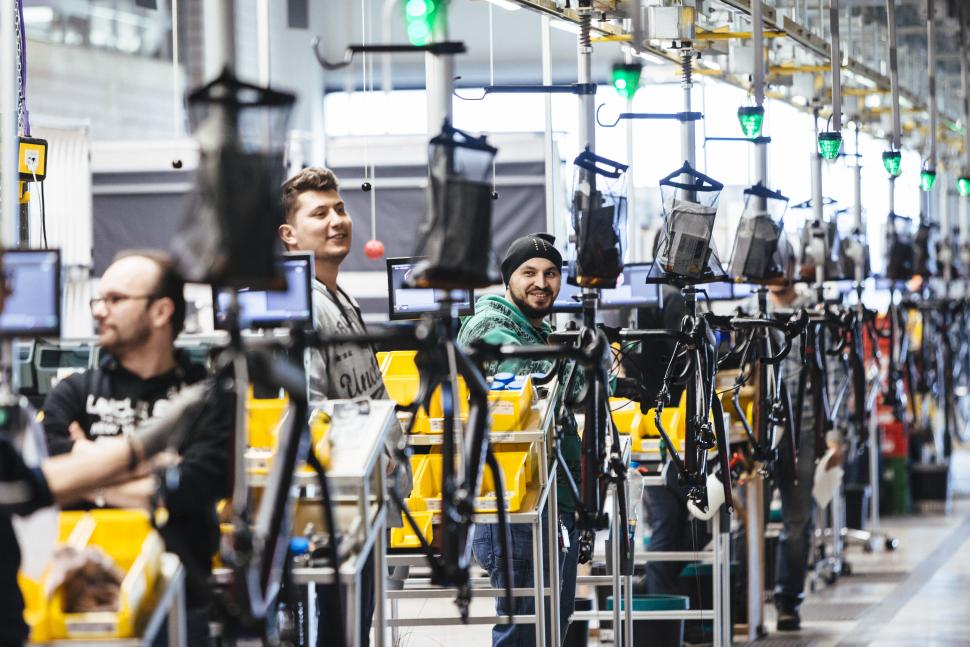
Before diving into what brands are (and aren’t) doing, it’s useful to know just where these emissions are coming from. Luckily for us, Trek, the largest manufacturer of bikes in the US, released its independent sustainability and corporate commitment report(link is external) in 2021. In this, the company highlighted areas of highest impact and the emissions produced to manufacture different bikes in its range.
Trek’s sustainability report

The report shows that while there are significant emissions due to transport, distribution, events and employee commutes, these are dwarfed in comparison to the scale of emissions related to the production of bikes.

2021 Trek Sustainability and Corporate Commitment report/WAP sustainability consulting
Another takeaway is the difference in emissions needed to produce bikes of different materials.
The chart above shows emissions for the Fuel mountain bike. The first four models are built around an aluminium alloy frame and the rest are carbon, the latter of which has a drastic impact on the carbon dioxide equivalent (CO2e) figure.
The carbon frames require almost double the CO2e to produce. Steel frames are better still, producing two-thirds fewer CO2 emissions than aluminium, and it’s also fully recyclable.
Of course, another way to reduce emissions from bike production is to source parts and materials locally, as this greatly reduces the environmental impact of transportation.
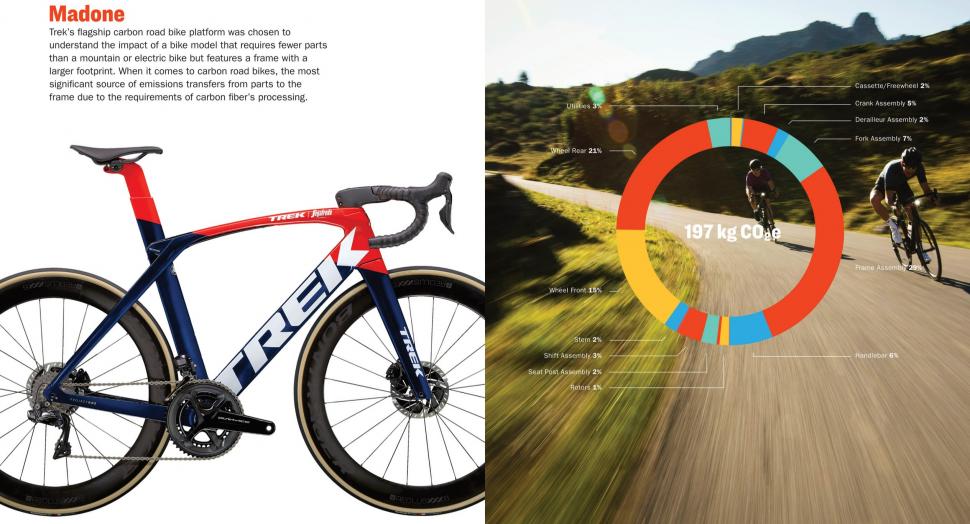
2021 Trek Sustainability and Corporate Commitment report/WAP sustainability consulting
Here is the breakdown of the most CO2e-intensive components. It’s worth noting that this Madone not only has a carbon frame but also carbon fibre wheel rims, handlebars and seat post. It’s once again clear that carbon fibre has a negative impact on the footprint of a bike, and the 197kg CO2e figure makes this well over Trek’s average 174kg CO2e figure, which also includes e-bikes.
Trek does point out that the footprint of its bikes (on average) is offset if it replaces a car for just 430 miles.
We’ve redone the calculation for the Madone (197kg CO2e) and the ‘Rail’ e-bike (229kg CO2e) as they are higher footprint bikes. They would need to replace a car for 488 and 567 miles respectively, so still well within what can be reasonably expected during a bike’s lifetime if you do indeed use it for transport rather than just leisure.
How about bamboo?
There are plenty of people out there who think that the big brands need to do more. We had a chat with Netham Bamboo Bikes(link is external), a small company from Bristol that is pioneering greater sustainability in bike production. As the picture below shows, Netham’s bikes are made of bamboo bound with hemp, and the lugs are recyclable aluminium.

We asked Netham where it thinks the biggest environmental gains can be made when producing bikes. Director Laura Niblett described transportation as a necessary evil, saying: “We live in a global world and whilst we should try to minimise our shipping we feel that it’s unrealistic to expect everything to be manufactured next to its end location.”
Niblett added that she thinks the transportation of bikes should happen by sea or land rather than air wherever possible, as although much faster it produces considerably more emissions to fly; and this is where, in her opinion, some bike manufacturers aren’t doing so well.
Then there are the materials used. Netham chose bamboo because the grass (bamboo is not trees, just to clarify!) is already carbon negative.
Bamboo soaks up a huge amount of CO2 and only takes five years to grow. Netham realises that although the material is “perfect for the vast majority”, there is still a place for bikes made of other materials.
For example, the advantages of carbon fibre for keen racers are undeniable. It would appear, then, that as always materials should be used in moderation. The sustainability and ethics of their source need to be carefully considered, and consumers should think twice when considering what they ‘need’ their bike to be made of.
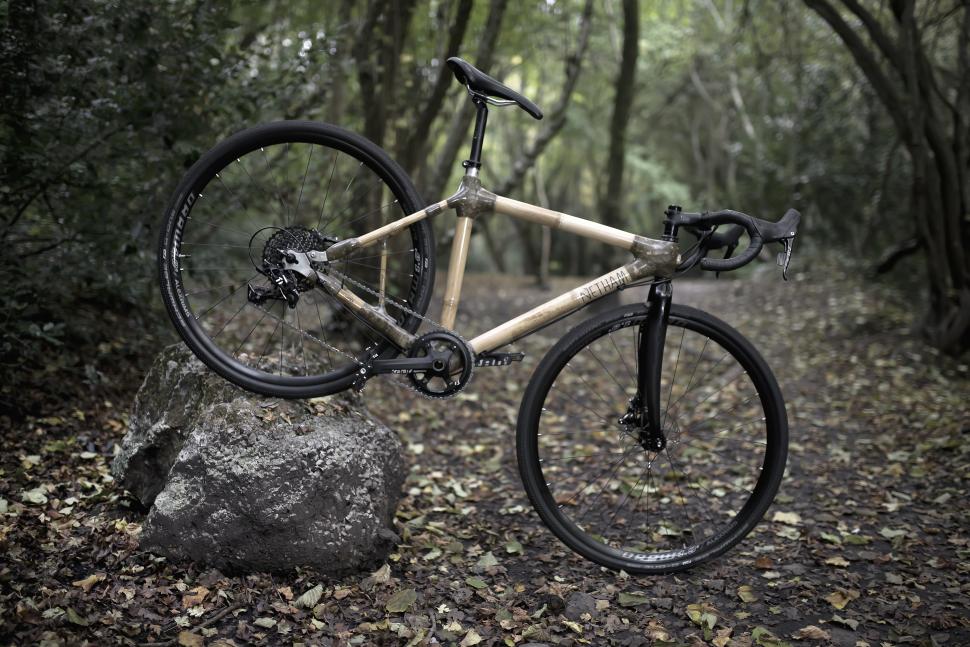
Niblett also brought up a point about the lifespan of bikes. Carbon bikes often get scrapped much sooner than bikes made of other materials due to their impact resistance and the expense of repairs. I have personally scrapped my fair share of carbon bikes following crashes, and also successful self-repairs followed by more crashing that eventually rendered the bike unusable.
We’re assured that the bamboo bike, in the very rare case that you do manage to break one, will come back stronger after a simple repair process using epoxy resin.
Netham urges consumers to carefully consider the material of the bike before purchasing, saying that buying once and trying to reduce our throw-away culture is the most sustainable choice.
And that brings us to epoxy, a name synonymous with being harmful to the environment. Niblett explained that not all resins are created equal, and that Netham has teamed up with Entropy Resins(link is external), which is bio-based instead of oil.
If a small company like Netham can find solutions, then why aren’t brands with huge R&D budgets able to find solutions as well?

The major drawback of using bamboo as a bike material is how labour-intensive the bikes are to make. Each frame takes 40 hours to make as the bamboo needs to be dried and handcrafted.
When asked if the big bike brands are doing enough, the simple answer was no. Niblett is of the opinion that it’s small start-ups that seem to be finding the solutions and not the bigger brands.
Realistically the only way that this is going to change is if brands are held accountable by their customers and the media.
Specialized
With this in mind, we had a chat with Will Chan, Engineering Manager at Specialized, to get a better idea of the company’s views on sustainability.
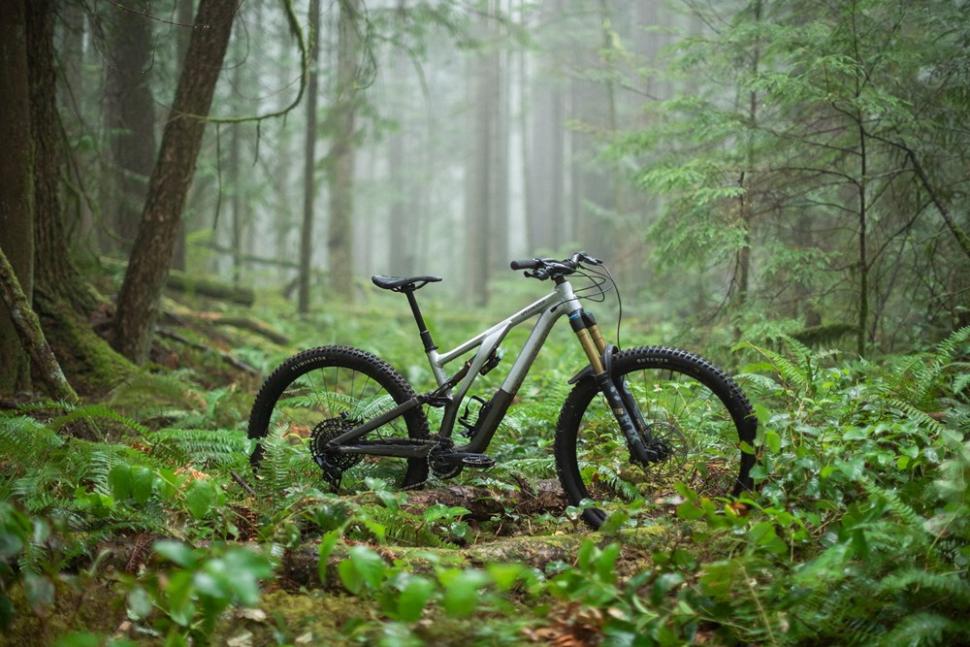
> Cycling is better than walking (or car sharing) when it comes to saving the planet finds a study
First, we asked which areas Specialized thought had the largest impact on the carbon footprint of a bike.
Specialized echoed the points from the Trek Sustainability Report, informing us that it is currently conducting an environmental report of its own using external consultancy firm Anthesis. The results of this study will be published in about a month from now, and aims to go one step further than Trek’s by including a full product lifecycle analysis including end-of-life.
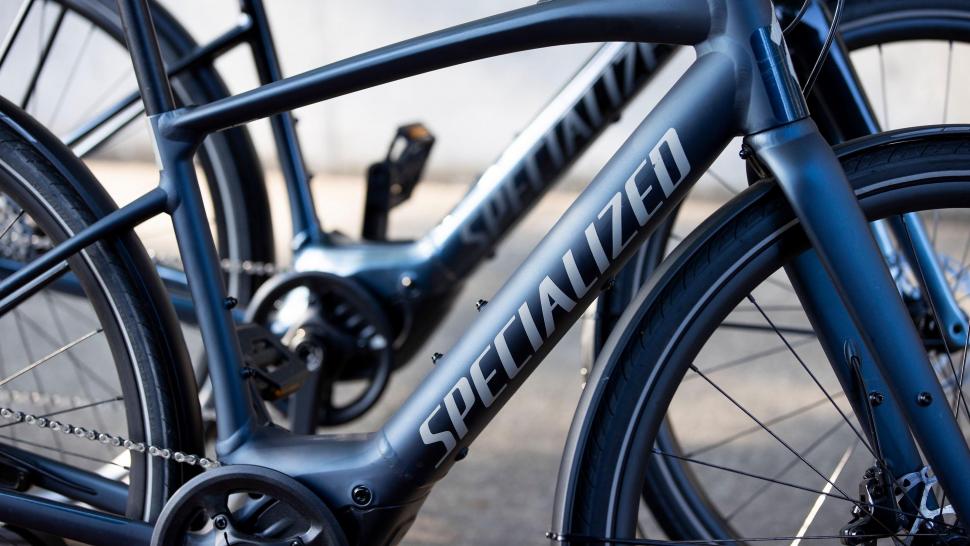
Despite the ‘Social and Environmental Responsibility Team’ at Specialized being created just two years ago, it does seem that progress is being made; for example, Specialized has reduced packaging and now only uses the two most widely recycled plastics where they’re still necessary. Their ‘Zero Waste Bike Packaging’ initiative means that all aspects of their packaging can avoid landfill.
It has also partnered with Redwood Materials to provide a battery recycling scheme that’s not exclusive to just Specialized bikes. This scheme has successfully recycled 10,000 lbs of lithium-ion batteries in the first six months of operation. While there is still some way to go, it is positive that we are beginning to see such initiatives come to fruition.
Specialized is also in the process of installing solar panels in its California HQ and is investing in green energy credits, which essentially means purchasing energy off the national grid with money that is then invested in renewable sources.
Earlier, we mentioned that carbon fibre bikes appear to have a higher footprint than aluminium or other materials. We asked Specialized for its view on this:
Chan explained that these numbers can be very misleading, as the scales of production are completely different.
“Alloy bikes have the overall greater impact simply because there are so many more of them,” he said.
Chan went on to explain that alloy bikes benefit from being part of a more mature manufacturing process, and that when items are made in larger quantities the footprint of each product can be smaller.
Specialized said that it has already made good progress in reducing the impact of carbon fibre; for example, its Power Pro saddle uses a carbon base made from reclaimed carbon fibre from ‘offcuts’ and waste material that the company produces.
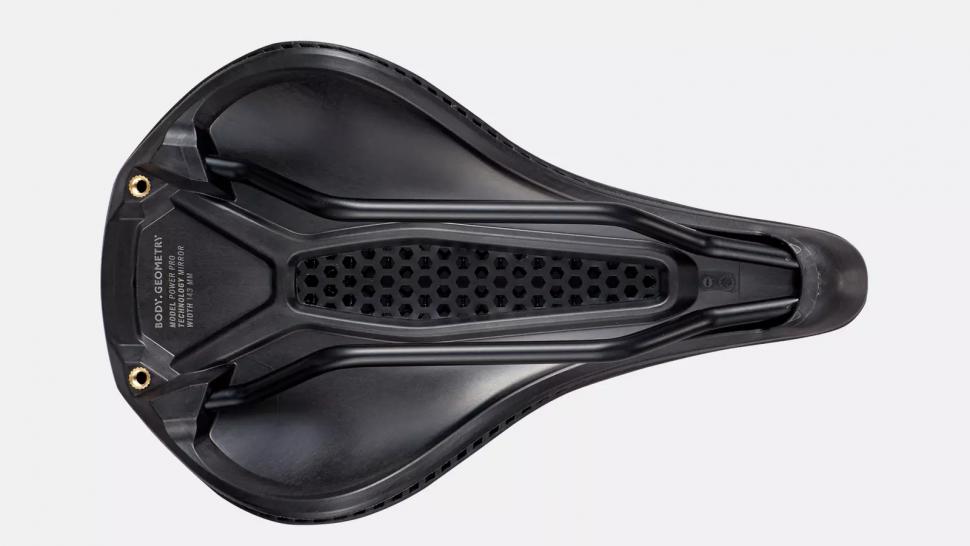
> Review: Specialized Power Pro with Mirror Saddle
Chan explained that it’s far easier to recycle unprocessed carbon fibre when there’s only one grade, rather than when there’s a mix of grades as is the case on most bikes.
He did also point out that this is a process that’s likely to mature, and as this happens there will be more uses for reclaimed carbon fibre. It’s realistic that in a few years, Specialized will manage to reuse all of its waste carbon fibre; but it’s unlikely that this will be used on bike frames, as the recycling process reduces the mechanical properties to a point where it’s best used for injection-moulded applications.

> Reynolds finds steel is ‘greener’ than titanium in study
When asked about how he thought the footprint of carbon fibre bikes could be reduced, Chan was honest about the fact the material requires a lot of energy to process, and that the majority Specialized uses comes from Japan, a country that still uses 87% fossil fuels (including natural gas).
Specialized says that while it will be looking for any possible way to reduce its environmental footprint, it will be channelling its efforts into where the biggest impact can be made. This will be influenced by the results of its white paper, but there will likely be a bigger focus on alloy bikes as these are produced on a much larger scale.
Chan added that “everything was on the table”.

In many cases, we kept coming back to the old saying of “Reduce – Reuse – Recycle”. This is something that many of us will have had hammered into us at school, but Chan explained that the order that they’re in is of utmost importance.
He also claimed that Specialized aims to reduce waste and keep building the best bikes it possibly can, as that will mean those bikes stay relevant for longer, adding that recycling isn’t an indefinite solution as there’s very often a limit to how many times even “recyclable” materials can go through the recycling process.
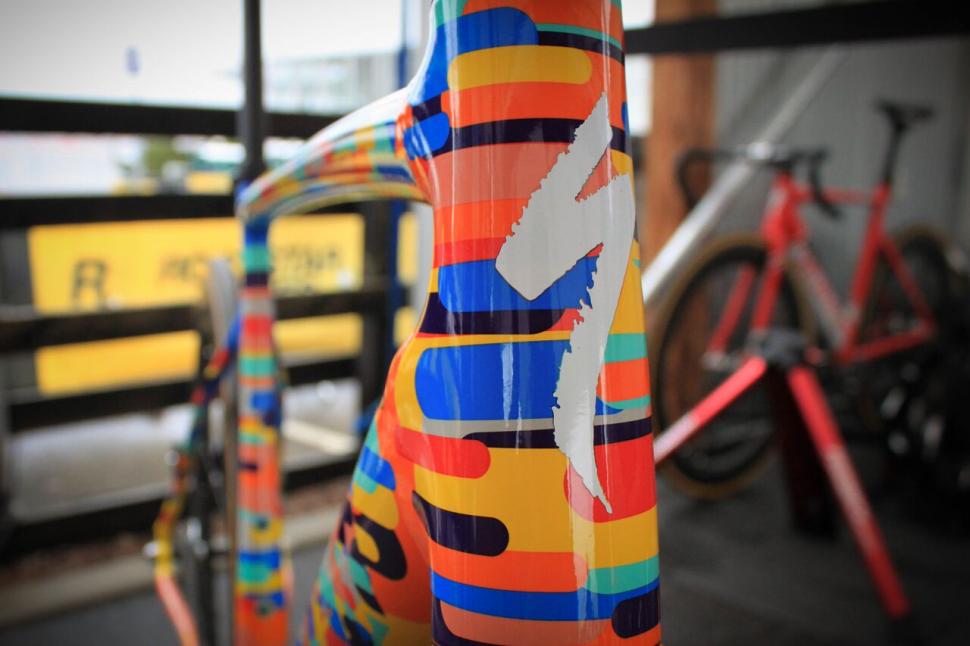
Finally, I asked Chan if he felt that the bike industry had a ‘free pass’ when it came to its footprint, and whether he felt bike manufacturers were doing enough:
“We never feel like we can do what we want on the pretences of the product being “good”, but it’s everyone’s [Specialized included] responsibility to do more.”
Chan added that Specialized is proud of the environmental progress it has made, and that staff are passionate about making changes for the better. He claims that there is “little” opposition to plans put forwards by the Specialized Social and Environmental Responsibility Team which allows them to introduce new ideas quickly.
Conclusion
A point that everyone seems to agree on is that bikes ARE part of the solution to reducing our transport emissions. To achieve this there needs to be a cultural change that will only come from an increase in bike-friendly public transport and cycling infrastructure. Currently (using 2020 data) the cycling modal share in the UK is just 2%. We’ve got a long way to go before we reach the Netherlands’ 26%.
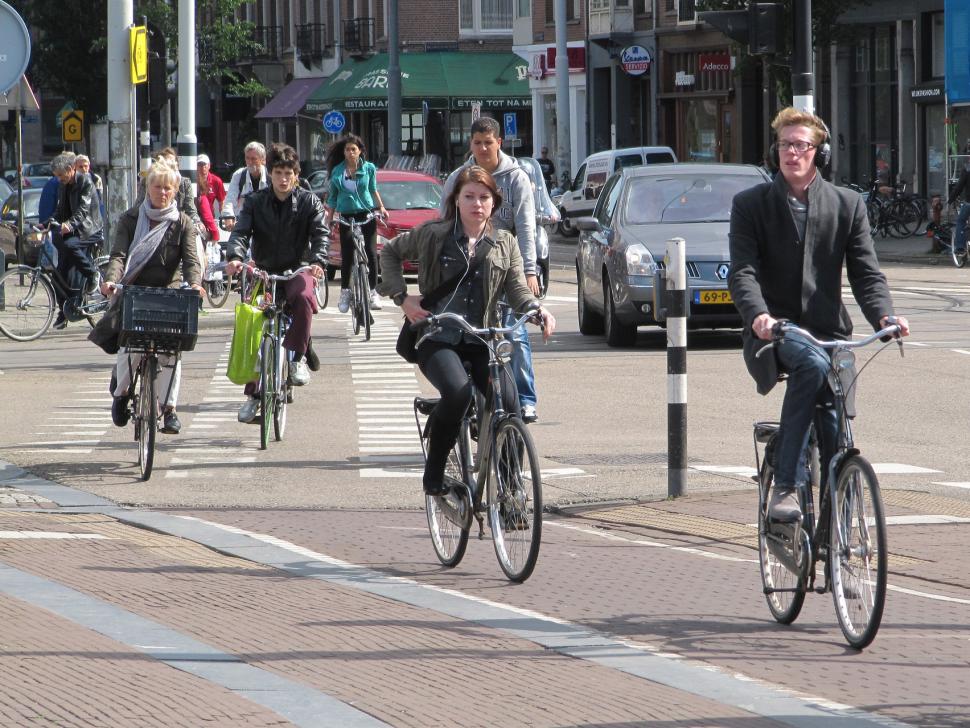
It appears that large bike brands feel the largest impact that they can have in reducing global emissions is to get more people on bikes. While this is true, it is positive to see that brands are beginning to make changes for the better and reduce the footprint of their bikes at the producton and distribution phase.
For many years the environmental impact of bike companies was largely overlooked; not, as we’ve come to realise, because they thought that as makers of zero-emission vehicles they had a free pass, but because like many industries, change was slow. It also wasn’t a priority for customers who were buying the bikes. While writing this article I’ve spoken to many passionate employees that are pushing forwards change, and this along with a shift in consumer values is changing the bike industry for the better.
From a consumer point of view: do think about what your bike is made from, and do ask where it came from. Think about how long it’s going to last… and most importantly, fly the flag to encourage more people onto bikes.
Source : Road





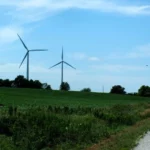


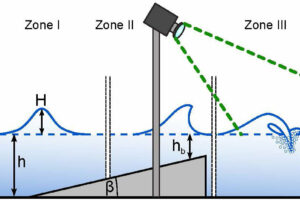


Add Comment